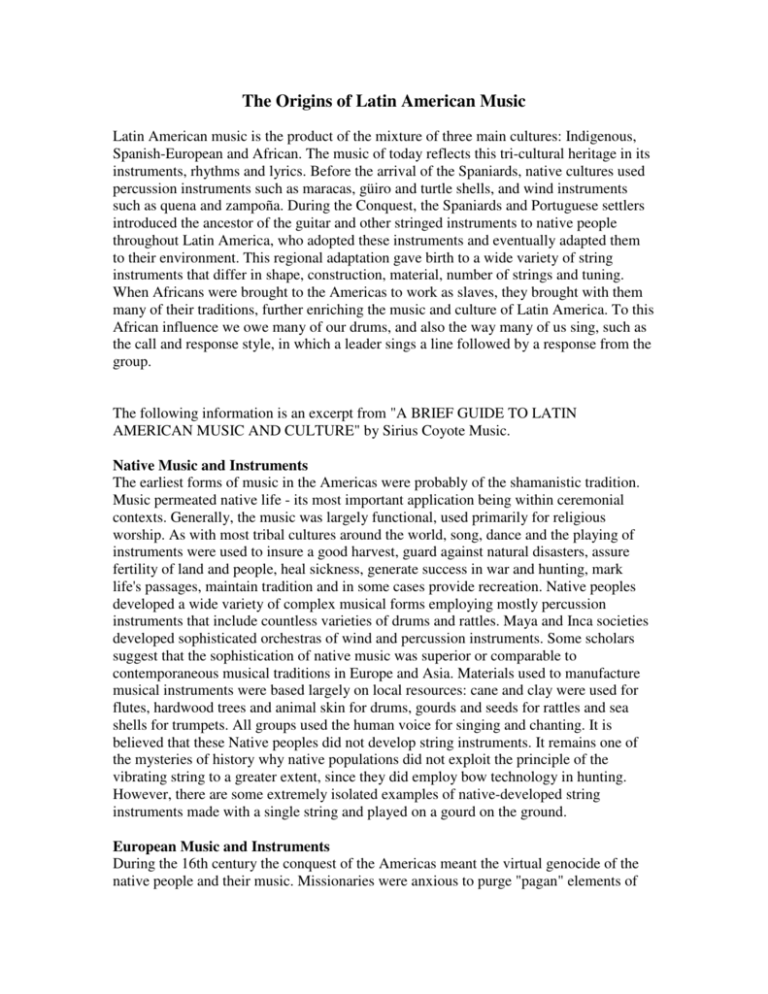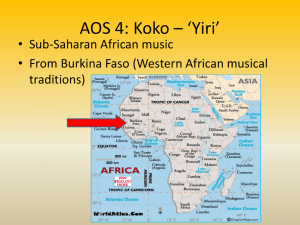The Origins of Latin American Music
advertisement

The Origins of Latin American Music Latin American music is the product of the mixture of three main cultures: Indigenous, Spanish-European and African. The music of today reflects this tri-cultural heritage in its instruments, rhythms and lyrics. Before the arrival of the Spaniards, native cultures used percussion instruments such as maracas, güiro and turtle shells, and wind instruments such as quena and zampoña. During the Conquest, the Spaniards and Portuguese settlers introduced the ancestor of the guitar and other stringed instruments to native people throughout Latin America, who adopted these instruments and eventually adapted them to their environment. This regional adaptation gave birth to a wide variety of string instruments that differ in shape, construction, material, number of strings and tuning. When Africans were brought to the Americas to work as slaves, they brought with them many of their traditions, further enriching the music and culture of Latin America. To this African influence we owe many of our drums, and also the way many of us sing, such as the call and response style, in which a leader sings a line followed by a response from the group. The following information is an excerpt from "A BRIEF GUIDE TO LATIN AMERICAN MUSIC AND CULTURE" by Sirius Coyote Music. Native Music and Instruments The earliest forms of music in the Americas were probably of the shamanistic tradition. Music permeated native life - its most important application being within ceremonial contexts. Generally, the music was largely functional, used primarily for religious worship. As with most tribal cultures around the world, song, dance and the playing of instruments were used to insure a good harvest, guard against natural disasters, assure fertility of land and people, heal sickness, generate success in war and hunting, mark life's passages, maintain tradition and in some cases provide recreation. Native peoples developed a wide variety of complex musical forms employing mostly percussion instruments that include countless varieties of drums and rattles. Maya and Inca societies developed sophisticated orchestras of wind and percussion instruments. Some scholars suggest that the sophistication of native music was superior or comparable to contemporaneous musical traditions in Europe and Asia. Materials used to manufacture musical instruments were based largely on local resources: cane and clay were used for flutes, hardwood trees and animal skin for drums, gourds and seeds for rattles and sea shells for trumpets. All groups used the human voice for singing and chanting. It is believed that these Native peoples did not develop string instruments. It remains one of the mysteries of history why native populations did not exploit the principle of the vibrating string to a greater extent, since they did employ bow technology in hunting. However, there are some extremely isolated examples of native-developed string instruments made with a single string and played on a gourd on the ground. European Music and Instruments During the 16th century the conquest of the Americas meant the virtual genocide of the native people and their music. Missionaries were anxious to purge "pagan" elements of native culture of which they did not approve; native religious practice, which invariably included music, was naturally a prime target. Instruments were destroyed outright and replaced with Western liturgical music. Some religious music brought by the missionaries was taught to the native and slave populations who, to their credit, reportedly reached such a high degree of proficiency that they rivaled the best musical ensembles of Europe. In 1522 the first European Music Conservatory was established in Mexico City to teach the liturgical choral music of the church. Eventually, European instruments, like the guitar, the piano and brass and wind orchestras along with their respective musical forms took root in the new environment and were woven into newly syncretized forms, the fruit of which we enjoy today. Colonial European music is still intact in some regions and heavily acculturated in others. The popularity of the march, polka, ballad and the many waltzes, bear witness to an extensive European contribution to Latin American music culture. Adoption of European scale systems, structures and harmonic vocabularies permeate Latin music. Some, like the so-called "Andalusian cadence" (A minor, G, F, E), are even traceable to the Moors of Spain. African Music and Instruments The major African contribution to Latin music is in its rhythmic enrichment. Many Latin American instruments, like drums, bells, rattles and flutes as well as some dances and songs are traceable to religions and ceremonial contexts in Africa. Perhaps African and European music combined more readily with each other than with native forms because they shared somewhat similar scale systems and harmonic textures. The African impulse is strongest in Cuba, Puerto Rico, Haiti, Brazil and the small countries of northeast South America. The result of this massive infusion of African culture was a diversification of music as witnessed by such popular forms as the Afro-Cuban rumba, Brazilian samba, Jamaican reggae, and Colombian cumbia, to name but a few. Elements of Catholicism syncretized with African religious practice, especially Yoruban spiritualism, which developed into acculturated belief systems such as Macumba, Candomble, Santeria and Vodun. Today, these religious sects predominate in Brazil, Cuba, Puerto Rico and Haiti, as well as in New York City, Los Angeles, Miami and other locations where there are large populations of Hispanic people. Music is an intrinsic and inextricable element in these religions; drumming and movement have always been an essential aspect of African worship. By maintaining some semblance of traditional religion and music in the face of slavery, African culture survived one of the most devastating chapters in its history.









